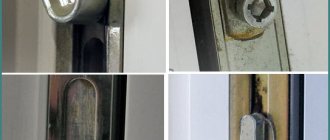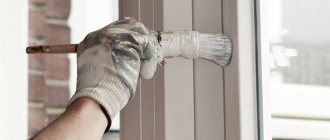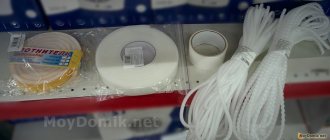The perfection of plastic window designs is far from the ideal presented in advertising. In practice, it turns out that both cold and loud sounds are allowed into the room. That is why the question of how to insulate plastic windows for the winter inside an apartment with your own hands arises over time for most of their users.
The perfection of plastic window designs is far from that ideal.
Preparing for work
Before you insulate plastic windows with your own hands, you need to carry out a complete diagnosis.
To do this, critical areas that allow wind to pass through are identified. It can come from different places, but it mainly comes from the window sill, window sashes and areas with worn out insulation. To understand where the wind is blowing from, you just need to raise your hand to different parts of the window. If this method does not help, then you can light a candle and sweep it across the entire structure, since fire is most sensitive to air currents. Rain can also help with diagnosis. Places where a lot of moisture has accumulated and lingered are the most problematic. If moisture was noticed in the middle of the window, this may indicate that there is a small crack in the glass.
The seal can be easily checked using a sheet. It must be inserted into the opening and the window closed. If the sheet is easily pulled around the corner, it means that the seal does not fit tightly to the frame.
Before insulating plastic windows with your own hands, you need to understand the purpose of the work. Naturally, this is done to save heat, but not every compromise can be made. You need to decide whether it is worth abandoning the aesthetic appearance of the window structure for the sake of savings or limiting access to the light flux.
Additionally, cost must be taken into account. Some materials are inexpensive. For example, sealant can be bought for several hundred rubles. Better and more durable solutions may require larger financial investments and the help of a qualified specialist. But don't be afraid of the high cost. High-quality insulation done once will please the owner for a long time.
It’s easy to do all the work yourself, but you can also resort to the help of specialists. It is quite possible to insulate the frame, window sill and replace the insulation on your own.
Before installing the insulation, do not forget to check the frame for chips and dents
It is worth remembering that windows have a warranty period. If during this period defects begin to appear on the windows, the company must eliminate all defects at its own expense.
It is necessary to insulate windows immediately before the onset of winter. This time is the most favorable for work. It is also necessary to take into account the specifics of materials. For example, a sealant can only be used in a certain temperature range, otherwise there is a risk that it will lose its properties.
How can you seal windows from the sun?
Everyone has a desire to escape the summer heat - some sit under the air conditioner, some douse themselves with cold water, and some eat ice cream. But to create an acceptable temperature in the house without having an air conditioner, you can stick a film on the window so that the sun's rays cannot penetrate the room.
You can see foil on some people's windows. The opinion that foil glued to the window will save you from the heat is wrong, since it is metallized, which means it only attracts the sun and heats the room more.
Sun protection film has two functions:
- From the side of the house it creates a pleasant shadow.
- From the street side, it reflects the rays of the sun and the room, accordingly, becomes cooler.
In addition, in this way you can hide from prying eyes, if there are no curtains, and from the sultry sunlight.
How to apply solar film?
This can be done by any person who does not have special skills in this type of activity. To do this job, you will need several tools:
- Window surface cleaner.
- Spray bottle for water.
- Plastic or rubber spatula (whichever is more convenient for you).
- A sharp knife for the job.
- Film for windows.
- First, you should thoroughly wash the window glass on both sides.
- Use a spray bottle to spray a homemade solution containing liquid soap and water onto the sticky surface of the film. It is better not to shake it too much, so that a lot of foam does not form. This solution will help you move the product freely on the glass in the way a person needs.
- Now you need to apply the film to the glass. After waiting for the foam to settle, use a spatula to smooth the film with gentle movements so that all formed bubbles are removed. Movements are carried out from the center to the edges of the film. Having achieved a perfectly flat surface, you need to let the product dry.
- At the end, you can trim off the excess film when it is completely dry and set. It is better not to adjust the desired size before gluing, as a small gap may form.
Before starting work, the window must be clean and dry. Only then will the film adhere well to the surface of the glass and last a long time. Now you don’t need to rack your brains and think about how to seal your windows from the sun.
Blowing from a plastic window, find and eliminate
Where can it blow from plastic windows?
To understand why it blows from a PVC window, you need to inspect the components, and for this you need to know the design principle of the window unit.
Construction of a window unit - main elements Construction of a plastic window and door - list of elements
The most common places for blowing:
- window glazing bead (glass unit holder);
- rubber compressor;
- window fittings (for example, blowing from under the hinges, into the handle);
- the perimeter of the window frame - the junction of the slopes, window sill, walls.
How to determine where it is blowing from a plastic window?
The presence of a defect in one of the components of the window unit leads to blowing from plastic windows. There are three ways to determine the exact location of heat loss from metal-plastic windows:
tactile hand. To identify a gap, just run your palm over the surface of the window block;
lighter. The search procedure is similar to the previous one, but the light is more sensitive to drafts and can detect even the weakest blowing.
paper. An ordinary sheet of paper is pressed against the window (put into the open window and clamped by completely closing the sash), if you pull the corner of the sheet and it easily pulls out, then the seal is not pressed enough (this may indicate that the window is operating in summer mode, the old seal is in this mode does not press well to the frame).
Why does it blow from plastic windows - reasons for heat loss
installation error. This is the most common reason associated with ignorance or non-compliance with the correct technology for installing a plastic window. 15 years ago, this service was so in demand that everyone who had at least some idea about installing window units became installers. Naturally, few people installed PVC windows according to GOST;
window distortion due to shrinkage of the house. A pressing problem for residents of new buildings and wooden houses;
an attempt to save money. One of the weighty arguments in competition is always price, especially during an economic crisis. The price reduction often occurred at the expense of quality: saving on foam, on insulation, ignoring the need to protect the heat insulator, using low-quality components when assembling windows - all this over time led to the fact that the consumer is forced to change or additionally insulate PVC windows;
physical wear of window components, in particular sealing rubber bands, or weakening of the pressing force of the sashes;
violation of the operating rules for plastic windows, which include the need to wash the window seal and treat it with glycerin. This care prevents the seal from losing its elasticity and cracking.
What to do if it's blowing from a plastic window
Of course, eliminate the source of the draft. From a practical point of view, there are two simple options - call a specialist to repair and adjust (expensive) windows or do it yourself (cheap).
The desire to seal all the cracks yourself using improvised means is nullified because: firstly, it is not aesthetically pleasing, and secondly, there are no guarantees.
When is it advisable to hire professionals:
The plastic window was recently installed. The installer company is responsible to the consumer for the reliable operation of the windows (if the warranty covers this period);
the window opening is located at a considerable height (in a multi-story building). It is better to entrust any high-altitude work to professionals (industrial mountaineering services). If the window is located on the second floor or higher, the work will be associated with increased risk;
if there is a manufacturing defect. For example, obvious manufacturing or installation defects that appeared during the warranty period;
if necessary, replace parts. It is better to install “original” fittings if it is necessary to replace individual elements of the window unit;
work is carried out in winter. Knowledge of installation technology and how to insulate plastic windows for the winter allows installers to complete the work quickly, without significantly cooling the living space.
However, often, the cost of hiring specialists is equal to the cost of installing a new window, and this fact makes it more profitable to do the insulation work yourself.
Pros and cons of the method
The method of insulating PVC windows for the winter using gluing has its advantages:
- ease of operation;
- availability;
- execution speed.
But when choosing this option, there are also disadvantages: this method will not always be relevant for plastic double-glazed windows.
On a note. It is better to glue wooden frames, and when installing double-glazed windows made of metal-plastic, it is better to immediately ensure that the window structure is installed according to the rules and without violating the tightness.
External window insulation
Proper insulation of plastic windows involves external and internal work. The first include:
- finishing of external slopes;
- insulation of ebb tides.
Each type of work requires its own approach, so it is important to consider them separately
External slopes
Most often, during the installation of windows, the external slopes are not finished, so they are the first point that should be taken care of when insulating a plastic window. Without this event, you can do whatever you want from within, but it will not have any effect. Insulating plastic windows on the street side makes it possible to move the dew point. This way, moisture condensation will not occur on the inside of the glass. This often leads to the appearance of mold, which not only spoils the appearance, but is also harmful to health. Another factor that requires finishing of slopes is polyurethane foam. If it is not protected from ultraviolet radiation and precipitation, it will begin to crumble, which will only intensify drafts.
To carry out the work you will need insulation, glue and tools. It is best to use extruded polystyrene foam as insulation for slopes. It has minimal thermal conductivity and is easy to install. This insulation also perfectly resists moisture and is not susceptible to rotting. To secure it to the wall you will need dowels in the shape of umbrellas, as well as special glue.
Note! If you want to use stone wool to insulate a slope, you need to take care of its high-quality waterproofing. If this is not done, then it will pick up moisture and lose its insulating properties, which will not solve the problem in any way.. First of all, you need to thoroughly clean the window slopes of debris
If there are sagging marks left on them from the old plaster, then they should also be knocked off with a hammer or a hammer drill with a chisel. If there are cracks or other damage, they must be repaired using tile adhesive or a similar solution. After this, the surface is coated with a deeply penetrating acrylic primer. If the first layer is absorbed too quickly, then you can apply another one and wait until it dries completely. Using a construction knife, the insulation is cut to the required size. An adhesive base is applied to it and it is placed in place. At the same time, it should fit snugly against the window frame.
The first step is to thoroughly clean the window slopes of debris. If there are sagging marks left on them from the old plaster, then they should also be knocked off with a hammer or a hammer drill with a chisel. If there are cracks or other damage, they must be repaired using tile adhesive or a similar solution. After this, the surface is coated with a deeply penetrating acrylic primer. If the first layer is absorbed too quickly, then you can apply another one and wait until it dries completely. Using a construction knife, the insulation is cut to the required size. An adhesive base is applied to it and it is placed in place. At the same time, it should fit tightly to the window frame.
Using a hammer drill, several holes are drilled in the insulation and the wall. A small amount of foam is blown into them and plastic umbrellas are clogged, which will additionally press the insulation to the wall surface. All remaining gaps that may exist between the insulation and the plastic window are sealed with glue. The insulation is covered with a small layer of glue. After this, a reinforcing mesh is mounted on it, which increases the strength of the slopes. Using a spatula, the mesh is pressed against the insulation so that the glue spreads evenly onto its surface. After grouting and drying, you can begin finishing work. You can watch a video about insulating window slopes below.
Working with tides
Insulating the ebb of a plastic window is not a difficult task, so it can be easily done and will not require large funds.
It is important to carefully inspect the space and eliminate all the gaps that exist between the wall and the window. A metal strip is mounted on the ebb, which covers part of the opening and prevents it from getting wet.
Under the bar you can place a small piece of insulation, which is firmly glued to the surface. All cracks are additionally filled with sealant.
Protection for polyurethane foam
PSUL (abbreviation for self-expanding tape) is glued to the frame before installing it in the window opening. Within about half an hour (depending on the ambient temperature), it increases in volume, filling the space at the outer junction of the edge of the opening with the window frame.
PSUL tape serves as reliable protection for polyurethane foam from all possible destructive processes, because it:
- does not rot;
- moisture resistant;
- does not deteriorate from exposure to sunlight;
- has good vapor permeability;
- when expanded, it perfectly fills small protrusions and irregularities;
- retains its protective functions at temperatures from -50 to +90.
The service life of the self-expanding tape is 50 years and, in theory, its protection is sufficient for external slopes. But, unfortunately, there are no ideal finishing materials.
Therefore, the self-expanding tape also needs protection, and such finishing protection can be the installation of external slopes.
How to insulate a plastic window from the street: basic steps
If you are using sealant. trim off the remains and level the surface.
Treat the slopes with a primer with special antibacterial additives.
If plastering is required, apply it using a square, after thoroughly cleaning the surface.
You need to cut a slab from expanded polystyrene to the size of the slope. Then attach it to the surface using mounting adhesive and dowels, and place the corner.
A fiberglass mesh is installed on top.
Fix the structure by coating it with glue. Once the slope is dry, coat it with water-based paint.
For internal insulation it is necessary
- Trim the foam and apply primer. After this stage, the surface is processed and the procedure is repeated;
- Plaster;
- Attach a sheet of foam plastic of the required size to the mounting adhesive;
- After drying and installing the corner, the structure is covered with putty;
- The last step will be to secure the casing.
You can cover a slope not only with plaster: plasterboard is increasingly used as a final finishing touch.
How to insulate windows from the outside
Adjust the sashes: each owner can do this simple work independently. It is necessary to tighten the necessary elements so that there are no gaps between the window and the window frame. Tighten the screws and check the mobility of the structure.
Often additional insulation is also needed for double glazed windows. A special coating is applied to the surface - an energy-saving film. All work must be carried out only in dry weather.
How to insulate the window sill of a plastic window
Improper installation of this part can lead to serious consequences: deep and wide cracks, strong drafts. Over time, the heat-retaining material dries out and defects may occur. You need to put polyurethane foam into the gap: such processing will not require much time. However, such a quick solution cannot replace repair work, which should be carried out in the summer or spring.
You can secure a sheet of plastic under the window sill by placing sealant in the resulting cavity. Leave a small gap: the seven or eight centimeters you marked will improve air circulation.
Some tips for those who decide to protect their apartment from the cold
Buy construction foam. When choosing, give preference to European brands - the quality of the material will ensure reliable insulation.
Remove any remaining old coating and thoroughly clean the resulting cavity.
Fill the gap, observing the position of the dispenser and noting any small cracks. A silicone-based product can deal with them better and more effectively.
To understand how to insulate plastic windows for the winter with your own hands, watch the training video
If your profile begins to leak cold, do not rush to contact professionals. Most of the necessary work can be done independently, spending a minimum of money on preparation. Turning to specialists should be a last resort: strict adherence to the rules and sequence of key actions will help you return warmth and comfort to your home in a short time.
Paper
Familiar to many from childhood and the most budget-friendly way to seal cracks is old newspapers and paper. Depending on the size of the cracks, the most suitable option for using waste paper is selected.
- The paper is cut into strips of 3-5 cm, moistened in paste or soap solution and glued to the window joints. Homemade blanks are often replaced with masking tape. You won't have to fuss with glue, and longer stripes will look much neater. Despite all the advantages, this insulation option has a significant drawback - the paper is often removed along with the paint when it gets warm.
- Thin tubes are twisted from album sheets or newspapers, which are tightly driven into crevices and cracks using a screwdriver, spatula or knife.
- Putty is made from waste paper. Newspapers are crushed, soaked, mixed with chalk and flour in proportions of 2 to 1. The solution is mixed to a medium consistency, and then used to fill cracks.
Ventilation of windows sealed with paper will have to wait until spring. In case it suddenly gets warmer in winter, it’s worth leaving at least one unsealed window.
How to change the seal
Special rubber bands are used as a seal on plastic double-glazed windows, improving sound and thermal insulation. They are available in different quality on sale. Rubber bands marked EPDM optimally combine affordable price and good quality, which is why they are most often purchased. Products with the VMQ brand are of high quality, but are too expensive. There is no need to buy TPE sealant, as it quickly deteriorates when exposed to weather.
Important!
There is also a seal with an adhesive layer on sale, which is attached to the window using the principle of adhesive tape. It is not a complete replacement for a conventional seal, so it is not advisable to buy it.
Seal replacement procedure:
- The seal that has served its useful life is removed by prying it by the middle. The freed space in the grooves is thoroughly washed with laundry soap or other detergent. Then thoroughly dry and degrease with alcohol.
- To make the fit tighter, the corners of the profile are glued with construction adhesive, PVA or silicone. After applying the composition, wait until it dries completely.
- After this, the rubber seal is prepared for installation. If material marked EPDM is used, it is measured along the length of the perimeter of the opening, since it bends easily. The remaining materials are cut to the length of the side of the opening with a small margin.
- Then the elastic is inserted into the grooves, being careful not to deform the material. It is more convenient to do this operation together using improvised tools.
To extend its service life, the rubber band should be washed and coated with silicone grease several times a year. After five years of operation, the seal is replaced with a new one.
Safety precautions
During work, it is necessary to comply with safety rules and requirements. This will help avoid unpleasant consequences. The main attention should be paid to the properties of the insulating material :
- Mineral wool. You need to work with it in a well-ventilated area. The cutting tool must be well sharpened, gloves, a respirator and special glasses must be worn.
- Sandwich panel. If the material needs to be cut, the respiratory tract must be protected from dust. To do this, just wet the panel with water or put on a mask (respirator).
Important! Before starting work, be sure to familiarize yourself with the safety precautions for each type of insulating material.
How to insulate plastic windows with your own hands
When to insulate windows for the winter
Repairs and insulation must be carried out before the onset of cold weather. This is due to the following requirements:
more comfortable working conditions;
material requirements. Some building materials, such as dry mixes and sealants, can only be used in a certain temperature range. Otherwise, they lose their characteristics;
optimal humidity;
no draft;
the ability to simultaneously perform internal and external insulation;
reducing the risk of catching a cold among apartment residents.
Insulating window openings for the winter
To insulate a window opening, you can use different materials and methods:
polyurethane foam. As the foam expands, it fills all the voids around the perimeter of the window opening, preventing air movement. Due to the fact that foam is 90% air, it is an ideal insulation material. However, the foam needs protection from ultraviolet radiation, high and low temperatures. This means that it is not advisable to use it by itself;
mineral wool. An excellent thermal insulation material for insulating window sills and internal slopes. Cotton wool has a more limited range of uses when insulating windows;
polystyrene foam/expanded polystyrene. Used for insulating slopes of plastic windows;
Note. Rigid insulation is used when the thickness of the installation seam is no more than 3 mm; in other cases, it is better to give preference to mineral wool.
silicone sealant. A reliable way to eliminate air leaks between plastic window elements;
dry mixtures for finishing slopes, used if necessary to insulate the window from the outside;
construction tape. Glues on top of the sealant or instead of it;
Advice. It is not recommended to use ordinary masking or window tape; after sticking it, unattractive marks remain on the plastic of the window frame that are difficult to remove without damaging the front covering.
Insulation of a window block
- seal;
- construction tape;
- sealant;
- heat-saving film for windows (energy-saving);
- mechanical methods of insulation, for example, tightening (adjusting) fittings.
After the question of how to insulate has been resolved, we will deal with the question of how to insulate a double-glazed window, frame, plastic, aluminum profile, etc.
Diagnostics of critical points
To determine what work is required, the window needs to be examined to look for places where wind and cold can pass through.
You can understand exactly where the window lets cold into the room using a simple technique: take an ordinary lighter or candle, and examine the perimeter of the window for the presence of blown areas, observing the deflection of the flame. If you don't have a lighter, you can use an open palm.
You should carefully examine the junction of the window frame and the wall.
On a note! You should carefully examine the junction of the window frame and the wall. Slopes, window sills and fittings are also subject to mandatory inspection.
It is especially convenient to find cracks on frosty days, when the temperature outside is contrasting compared to the room.
Causes of drafts
You should also have basic information about the causes of drafts. Having basic knowledge, you can avoid such unpleasant situations in the future.
- Making mistakes during window installation. One of the most common problems associated with the low qualifications of the installer. If a draft occurs immediately after installation, then you need to contact this installation company again and demand that the defects be corrected. If you install plastic windows yourself, you need to check the correct installation and correct any errors.
- Shrinkage of the soil under the house and, as a result, skewing of windows. A rare problem that occurs among residents of new houses.
- Poor quality materials and manufacturing defects. An attempt to save on the price of double-glazed windows can cause poor window sealing, but even owners of expensive windows are not insured against defective parts. If the terms of purchase allow, take advantage of the opportunity to return the entire set or only the defective parts.
- Physical wear and tear on the locking parts of the window and seal. A very common problem for window owners who have been using them for a long time without replacing them.
- Violation of the rules of use and care. Over time, the sealant may lose its properties. To prevent this from happening prematurely, it is necessary to wash it and treat it with emollients. For example, glycerin.
If you evaluate in detail all the causes of drafts and heat leaks, you can divide them into two categories based on the possibility of eliminating them - with the help of window installation specialists and solving problems yourself.
It is best to use the services of professionals to solve the following problems:
- If problems with the window are identified during the warranty period. At this time, the installer company bears full responsibility for its operation. Independent intervention in the design features may result in denial of further warranty service.
- External work at height is required. In such conditions, the likelihood of injury greatly increases, and it is better to entrust such work to professional workers.
- Detection of manufacturing defects during the warranty period.
- Replacement of some structural parts, requiring certain tools and skills to work with them.
If the work is done from the inside, then most of it can be done independently.
cotton wool
Sealing cracks with cotton wool or soft cloth is in many ways similar to the previous insulation method. Using a sharp object, the material is pushed into the frame joints. Adhesive tape or a strip of fabric soaked in soapy water is glued on top.
The disadvantages of insulation with cotton wool are the same as with paper:
- Inability to ventilate a window when the temperature rises temporarily;
- Paint peeling off when removing strips of fabric.
In this case, the cotton wool can be easily removed when “unpacking” the window. It does not turn yellow or harden during the winter. Cotton wool for work can be used both technical and ordinary household.
Internal insulation of windows
The process of how to insulate windows with your own hands also includes the interior finishing of some components. These include:
- internal slopes;
- insulation;
- windowsill.
Insulation will require special patience and care.
Internal slopes
The process of how to insulate the slopes of plastic windows from the inside is very similar to what was described above. Internal slopes require careful processing to achieve a pleasant appearance. It must match the chosen interior. The first step is to cut off the protruding foam, and also add it in those places where cracks have formed. The old finishing that was near the old windows is completely removed. The surface of the slopes is treated with a deep penetration primer and left until completely dry. The next step is to install drywall, plastic panels or putty and plaster.
Note! After finishing, the slopes can be painted using water-based paint or finished with decorative plaster, which is better than using plastic panels.
Windowsill
The window sill is an integral part of the window. For plastic windows, PVC window sills are used, which can be of various sizes and designs. But the correct installation must unite them. First of all, you need to find out where the heat loss is going. The gap can be between the window and the window sill, as well as the window sill and the concrete part. In the first case, it is necessary to seal the gap with sealant. For a white profile, you can purchase white sealant, and for other colors, transparent is perfect if the required color is not available.
If it blows from under the window sill, then certain mistakes were made during its installation. In cases where complete dismantling of the window sill is impossible, there is an option using foam to try to blow out problem areas. After the procedure, it is advisable to place something heavy on the windowsill so that the foam does not deform it and lift it up. If you have the opportunity to remove the window sill, you can additionally foam the junction of the window and the wall. A small layer of insulation is also placed under the window sill.
Advice! Insulation can be done using a special film. The process of such insulation is shown in the video below.
Paper tape
- If you don't want to bother too much, you can seal the window with tape. In this case, you shouldn’t hesitate, because masking tape (the most popular in this matter) begins to appear on store shelves quite early - in the first months of autumn. If you haven’t had time to stock up on the necessary equipment, don’t worry.
- As an alternative, take regular tape (wide, of course). You will also need a hairdryer for melting ice on windows and non-sterile cotton wool, which can be easily found at the nearest pharmacy. You need to make bundles of cotton wool and then place them in the cracks.
- Before you start insulating, first dry the windows with a hairdryer - this way the tape will stick better. The last step involves sealing with tape. This method will allow you to quickly insulate your home, but it has its drawbacks: such adhesive material may not adhere well.











